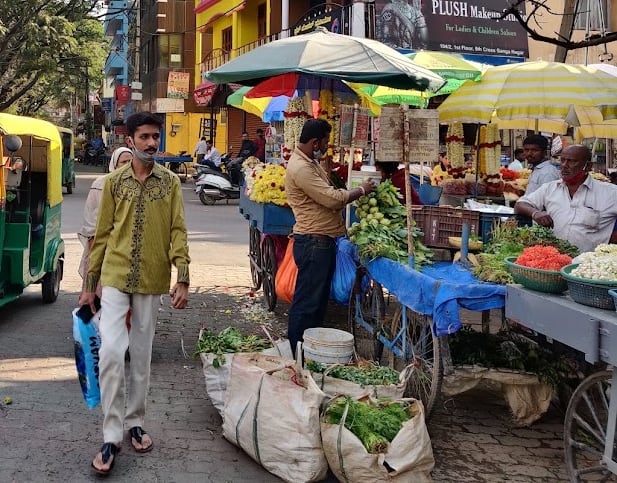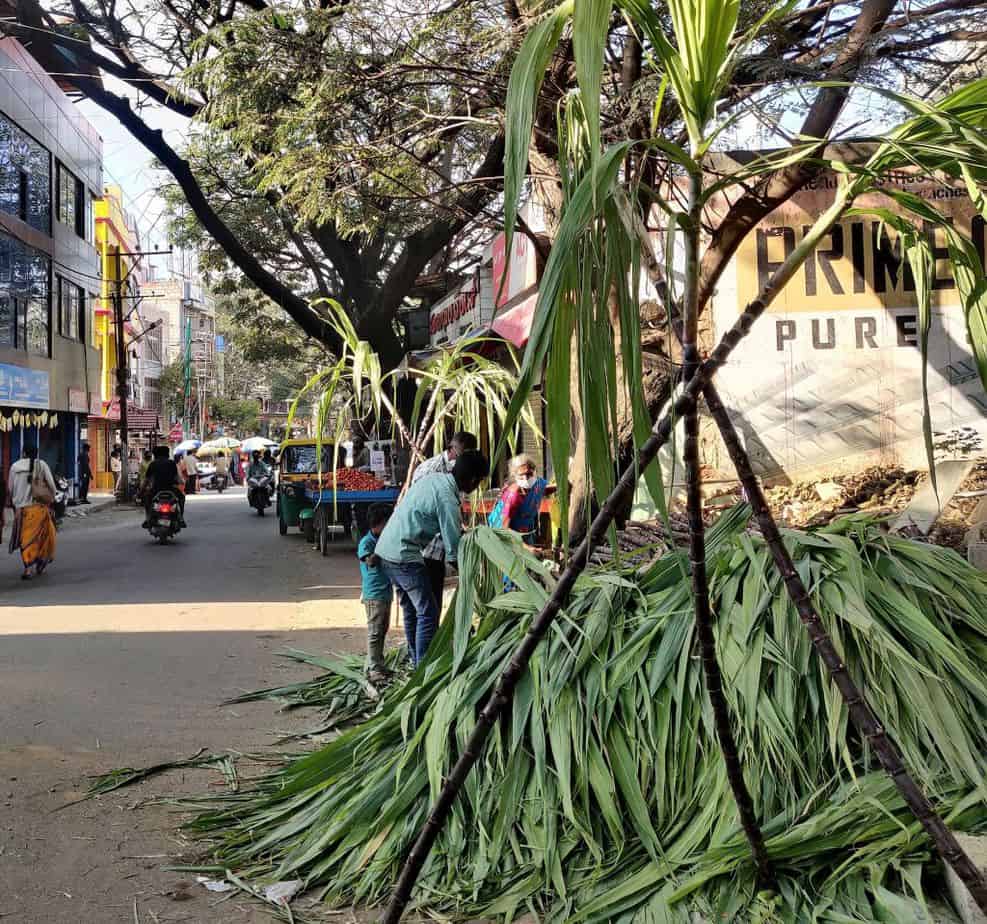Rani N, 48, a fruit vendor who sits opposite RT Nagar post office, is warding off flies from her precious guavas. At night she sits in a barely lit corner, shrouded further by a large red umbrella that protects her from rains.
Rani had migrated from Tamil Nadu to Bengaluru over three decades ago as a 16-year-old newly-wed. She and her husband wanted to escape the droughts in Tamil Nadu and pay off their debts.
She has been selling fruits for the past five years. As a relatively new entrant to street vending, Rani has little access to certain areas of high commerce earmarked for veteran fruit sellers, though she is a fluent Kannada speaker. She is shunned from RT Nagar market square, a bustling economic hub 500 m away. The square is occupied by those hawking there for decades. Rani cannot move up the street to better-lit spaces either, as those in the adjoining shops would oppose her obstructing their hoardings.

Lack of networks disadvantages migrants
A study published last year by the Institute for Social and Economic Change, documenting migrant and native female street vendors in Bengaluru, found significant differences in the investments made by these groups. To earn the same level of income, “migrants need to invest more than natives”, the study found.
Native vendors were found to have longer years in the sector, which helped them acquire a higher number of “acquaintances in the market and regular customers”. This gave them an edge over their migrant counterparts in terms of getting ahead of customer trends and building a network they could reach out to.
Rani says she loses out on business during festive seasons as customers frequent only the square: “During festivals all customers go there, they don’t come here”. RT Nagar square boasts a heterogeneity of produce – various fruits, vegetables and flowers – spread across 50-60 vending carts. Which is convenient for customers as they get everything they want within a small radius.

Rani had applied for the PM SVANidhi scheme (that offers micro credit to street vendors), to diversify her ware. “But I received a reply saying I am not eligible for it because I already have loans under my name,” she says. The scheme was launched during the COVID second wave to help street vendors scale up their business, but remain inaccessible to many.
The lack of access to capital and market knowledge remain major setbacks for migrant vendors like Rani.
No secure workplace
A street vendor’s work is premised on their ability to push their cart around and park it on a public spot which then becomes their workplace. And it is important for a street vendor to be located in an area with greater footfall and people in transit.
In his book ‘Urban headway and Upward Mobility in India’, Dr Arup Mitra, Professor at the Institute of Economic Growth, Delhi, uses case studies to discuss how migrants rarely have access to gentrified areas with high-density economic activities. By extension, they can only access a narrow spectrum of jobs available in their neighbourhood.
Independent researcher Swathi Shivanand says migration to Bengaluru from Tamil Nadu and the Telugu states precedes that from northern Karnataka; but vendors and workers who migrated from other states have long been bearing the brunt of a social embargo imposed on them. Research also highlights the hurdles migrants face in securing housing and healthcare. These factors prevent migrant street vendors from using spots occupied by native vendors.
As per the Street Vendors (Protection of Livelihood and Regulation of Street Vending) Act, 2014, Bengaluru’s municipal corporation BBMP is supposed to identify Permanent Vending Zones for street vendors. BBMP also has to set up Town Vending Committees (TVCs), which should then conduct surveys to identify street vendors and issue them vending licenses. However, as Citizen Matters reported in January 2021, the Act is still in the nascent stages of implementation in Bengaluru – TVCs meet irregularly, the survey is stalled, and vending zones have not been demarcated.
Read more: “Street vendors are claimants, not intruders”
The absence of notified vending zones increases vendors’ uncertainties regarding their workplace amid threats of eviction. The local police have asked Rani multiple times to vacate her spot; she says she cannot afford to bribe them like other vendors do.
The vendor occupying the spot next to Rani is also a migrant from Tamil Nadu. Rani trusts him to accept her customers’ digital transactions on her behalf since she handles only cash. This, and her fond interactions with her customers, hints at a niche circle of confidantes that Rani has carved out for herself. But, when faced with the ire of law enforcement agencies, the neighbouring vendor is as unprotected as Rani.
Othering
Latha (name changed), another vendor from Tamil Nadu, sits along the stretch of road leading right up to RT Nagar square, but not quite inside the square. She says the square is filled with vendors native to Karnataka, and that she faces hostility from the “locals” here.
Recalling how her business was borne out of petty investments, she says she has to put up with rude customers too: “The customers also say, you’re from outside Bengaluru, why are your prices so high?”. She believes it would have been easy to counter their abuse if she was more fluent in Kannada. “The onus of pacifying such customers falls on us, because it is so easy for them to complain and garner support [of other customers].”
Such “othering” of migrants has been reported from several Indian metros. A migrant identity “keeps the poor from being recognised as full residents entitled to the full complement of civic right(s) and social opportunities,” says sociologist Prof Amita Baviskar in her paper ‘Between violence and desire: space, power, and identity in the making of metropolitan Delhi’.
Resident of a neighbouring colony in Dinnur, Latha says migrants such as her seek out cheaper housing and find vending spots closeby. However, Manipal T, a vendor from Kerala, disagreed. Sitting at the busy stretch between RT Nagar square and the nearby Ganganagar market, the 68-year-old mason-turned-street vendor said he experienced no resistance when he chose this spot for selling yams and lemons.

“Most people who sell nearby are migrants only,” he says, but adds that he received no help from his community or people from his village while setting up his business. Rani, Latha and Manipal hinted at not having friends in the region who they could depend on or call for support.
Ashok, a jalebi seller in Sanjaynagar, came to the city through a kinship network. “I came with my cousin who now works in Kolar. He supported me in procuring items and setting up shop,” he says. When asked why he doesn’t shift to the food street in Sanjaynagar 2-3 km away, Ashok says, “No, I don’t like it there. Here, there are more Hindi-speakers,” adding that he had faced language-based exclusion in the city.
Representation in unions
There has been some evidence that migrant workers generally are either under-represented or not part of trade unions in the localities they work in, which prevents their concerns from being mainstreamed.
However, S Babu, President of Bengaluru Jilla Beedhi Vyaapari Sanghatanegala Okkuta (Federation of Street Vendors’ Unions of Bengaluru), told me that a lot of intra- and inter-state migrants are part of their federation. He said that the meetings of the Federation and the TVCs happen in Kannada, and that migrants have no trouble following the proceedings. However, none of the vendors quoted in this article are part of the Federation or any street vendors’ union.
Read more: How street vendors survive in “silent” Sadashivanagar
Babu is unaware if the migrants find it harder to obtain vending licences or are more vulnerable to police harassment. The 2014 Act mandates that the TVCs be made up of 40% of street vendors, who are elected by vendors among themselves. However, only those with a valid vending licence and a voter’s ID can contest in elections to the TVC. Of the vendors quoted in this article, none except Ashok had a vending licence.
The pandemic was also a stark reminder that it’s migrant workers who are more vulnerable in the face of a crisis.
With inputs from Shubhra Sharma and Priyanka Akkar, Urban fellows at Indian Institute for Human Settlements